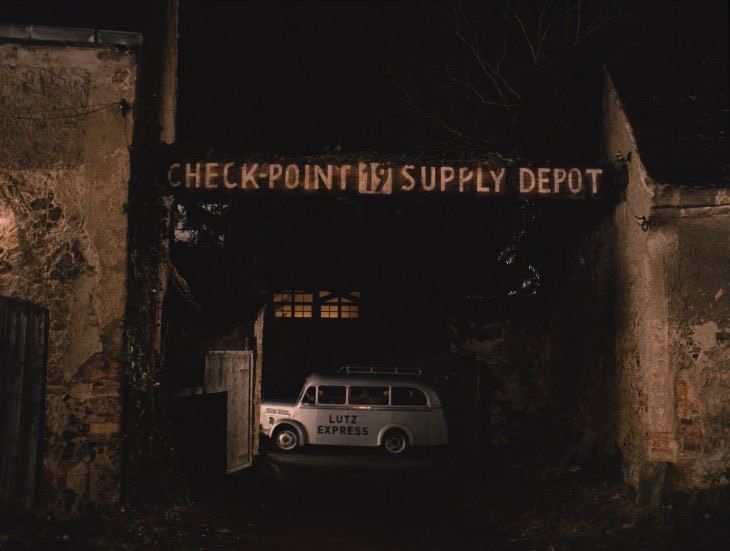We were tasked to analyse the cinematography from the 21st chapter of The Grand Budapest Hotel. We discussed each individual shot in class and analysed the employed cinematographic techniques throughout.
Chapter 21: Check-Point 19 Supply Depot
In the first long shot, Anderson establishes a symmetrical frame with in a frame. The ratio is 4:3 to inform the audience of the time period (1932). Our attention is then focused on a car which enters the frame towards the centre. The camera then pans 90º to the right, through which our attention is now drawn towards the manhole cover illuminated from above. The camera then dollies forward to allow the viewer to read the text on the manhole cover. Zero then enters the frame to the left and peers into the manhole.

Anderson then cuts to a symmetrically framed long shot of the prison cell interior, in which more frames within frames are featured. The lights then go out while the actors perform highly choreographed movements in order to escape. As the lantern is lit, the viewer’s attention is focused towards the hole in the ground. The camera then pedestals down, following the centrally framed lantern through the floor and into the tunnel.
We then cut to a centrally framed, symmetrically composed closeup of a conveniently illuminated and labelled button, expertly focusing our attention.
The camera then crabs right to reveal the labelled dumbwaiter, through which another frame within a frame is composed. The viewer’s eyes are drawn directly to this specific location, as a character then enters the frame through the dumbwaiter. The camera then crabs back left, resting on the symmetrically framed door. As the camera continues to crab left, we follow the running men as we come to rest on the ladder.
It then cuts to a symmetrically composed frame of the prison gallery, through which our attention is directed to the centre. The long ladder then descends through the established frame. We then cut to a different view of the ladder, which presents us with a labelled wall, in order to inform the viewer of the location.
Anderson cuts to the opposite 180º angle, breaking the 180º rule in the process. Through a symmetrically constructed frame within a frame, our attention is focused on the smaller frame through which a character appears. A shot/reverse shot sequence then takes place, between the escapees and the prisoner, in which the characters are framed appropriately.
We then cut to a wide shot through which the characters enter the frame. The camera pans 90º and rests on a labelled lift door. We then dolly forward into the guard bunk room. The frame is dimly lit and the shadows are meticulously framed as the characters nimbly navigate their way through the bunk room. The film then cuts to a low angle shot of the men crawling under the bunks.
We cut to a frame within a frame of the characters cutting the prison bars in sync. It then cuts to a wider shot in order to show the frame in the larger context of the prison wall. The characters then throw the long ladder outside.

Anderson cuts to a birds-eye-view shot which shows the colossal height of the building as well as the length of the ladder. The frame is conveniently lit to show the path. We then cut to an extreme long shot which shows the men climbing down the side of the building, emphasising the sheer size of the prison.
It cuts to a shot depicting the windows as the escapees climb along the edge, the camera then crabs right to show the progress. The frame within a frame features a conveniently labelled steam vent.
A wide shot is established to portray the laundry basket landing point, our attention is focused on this centrally framed area. The men enter the frame downwards through the vent which is lit from above. As the characters land, they are symmetrically placed. We then pedestal down to reveal a centrally framed trapdoor.
We then cut to a worms-eye view frame within a frame of the prisoners looking down the trapdoor. A sequence which alternates between birds-eye and worms-eye shots then occurs. The trapdoor remains consistent and the characters are symmetrically positioned.
The film cuts to a wide shot, through which a prisoner armed with a knife enters. We cut to a worms-eye view portraying the other characters’ reactions in which they are all still symmetrically placed. Finally, a birds-eye shot displays the aftermath of the stabbings.

Well written, with good use of technical terminology. Don’t forget, though, to comment on the director’s intentions or the effect on audience…
LikeLike